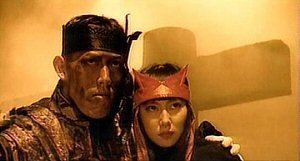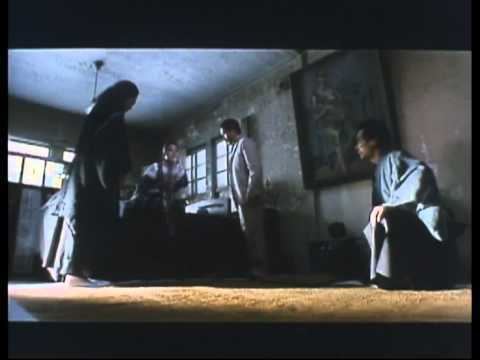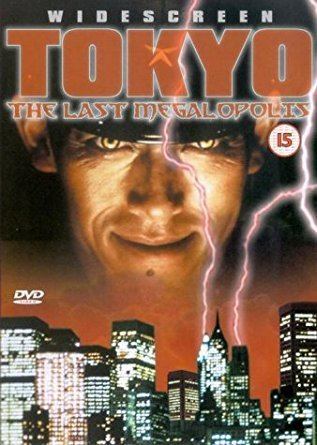Tokyo: The Last Megalopolis
6.6 /10 1 Votes
Duration | 6.4/10 IMDb Genre Horror, Sci-Fi, Thriller Budget 1.8 billion JPY | |||||||||||||||||||||||||||||||||
 | ||||||||||||||||||||||||||||||||||
Release date January 30, 1988 (1988-01-30) Cast Shintarô Katsu (Eichi Shibusawa), Kyusaku Shimada (Yasunori Kato), (Keiko Tatsumiya), (Yoichiro Tatsumiya), Tamasaburo Bando (Kyoka Izumi), Haruka Sugata (Yukari Tatsumiya)Similar movies Don't Hug Me, I'm Scared , TRON: Legacy , Finding Neverland , Epic , The Chronicles of Narnia: Prince Caspian , I, Frankenstein | ||||||||||||||||||||||||||||||||||
Tokyo: The Last Megalopolis (Japanese: 帝都物語, Hepburn: Teito Monogatari) is a tokusatsu historical dark fantasy/science fiction epic film directed by Akio Jissoji, produced by "Exe" studios and distributed by Toho Studios. It is the first cinematic adaptation of the award-winning historical fantasy novel Teito Monogatari by Hiroshi Aramata. The plot is a reimagining of Tokyo's early 20th century history from an occultist perspective. The film stars Kyusaku Shimada, Shintaro Katsu, Koji Takahashi, Jo Shishido, Junichi Ishida, Mieko Harada, Ko Nishimura, and Shiro Sano among others. With a budget of around 1 billion yen (roughly $8 million), the movie was one of the most expensive live action Japanese special effects films to have ever been produced during that decade (by contrast, the internationally released 1984 film The Return of Godzilla was only budgeted at $6.25 million).
Contents

The movie went on to become a notable success in Japan. It was the third highest grossing Japanese motion picture of 1988. It continues to be regarded in the country as a respected cult film although its reputation is relatively unknown in the rest of the world. The movie helped propel the careers of some important figures in the contemporary Japanese film industry and aided in kicking off a new wave of similarly themed fantasy occult media (see "Legacy" below).

Plot

The live-action film is an adaptation of the first 1/3rd of the original novel or the first four volumes (out of a total of 12).

The movie begins in 1912 with Yasumasa Hirai explaining to Baron Eiichi Shibusawa Tokyo's long history as one of the most haunted cities in all of Japan. He specifically warns Shibusawa that the onryo Taira no Masakado must not be disturbed, as its spirit is powerful enough to destroy the city. In response to this heeding, Shibusawa allows the Tsuchimikado Family to advise him on how to make Tokyo a blessed city. However, both Hirai's and Shibusawa's efforts are opposed by the oni Yasunori Kato, a former lieutenant in the Imperial Army, who wants to destroy Tokyo by awakening Masakado's spirit. To do this, he attempts to kidnap Yukari Tatsumiya, the descendant of Masakado, to use as a medium to communicate with the spirit. However, his plans are brought to attention to the Tsuchimikado Family by Koda Rohan. Hirai and his followers lock Yukari inside the Tsuchimikado temple and perform the monoimi ceremony to defend her. Kato and his followers launch a frontal assault against the temple with shikigami. Kato escapes with Yukari and uses her as a medium, but Masakado rejects his offer. Ogai Mori diagnoses Yukari as pregnant with Kato's child. Emperor Meiji passes away, marking the end of the Meiji Era. In a dramatic display of devotion to the Meiji Emperor, Hirai commits seppuku. However his act divines the year of Tokyo's destruction; 1923, the Year of the Pig.
The narrative moves to 1923, Tokyo. Kato retreats to Dalian, China and he and his followers use magic to cause artificial earthquake waves that are amplified to Japan. Kato returns to Tokyo to awaken Masakado's spirit by himself, but is interrupted by Koda Rohan and Junichi Narutaki, who use Kimon Tonkou magic against him. Kato fails to awaken Masakado, but manages to stimulate the Great Kanto Earthquake.
The setting moves to 1927. Torahiko Terada has been appointed by Noritsugu Hayakawa as manager of the construction of Japan's first Tokyo Metro Ginza Line. Hayakawa's construction workers run into Kato's shikigami provoking Terada to seek out the aid of Dr. Makoto Nishimura to use his creation Gakutensoku to finish construction for them. Masakado summons Keiko Mekata, a miko, to defend his grave from Kato. Keiko joins forces with feng shui master Shigemaru Kuroda, who discovers the location of Kato's hideout. While Kuroda fights an Asura statue guarding the place, Keiko rushes to stop Kato, but Kato summons his gohō dōji to fend her off. Kato attempts to awaken Masakado through Yukari's child, Yukiko, but even this is unsuccessful. Keiko explains to Kato that Yukiko is not his child, but rather the result of an incestuous union between Yukari and her brother Yoichiro making her uncontrollable by Kato. Gakutensoku self-destructs, cutting off the spiritual energy veins connected to Kato's temple. Kato tries to use onmyodo magic one last time to stimulate an earthquake, but this is insufficient and he is severely wounded from the effort. Though his plans are foiled, Kato kidnaps Keiko and takes her with him to Manchuria. The film ends amidst another annual district wide festival celebrating the birth of the capital. The Tatsumiya Family hopes for Keiko's return while Kyoka Izumi predicts Kato's return.
Cast
Other cast members include Seiko Ito as Wajiro Kon, Hideji Ōtaki as Oda Kanno, Hisashi Igawa as Ryokichi Tagami and Ai Yasunaga as Azusa Nishimura. Hiroshi Aramata does a cameo as a brasserie client.
Production
The film began being produced around early 1987. Swiss artist H. R. Giger was commissioned to design creatures for the movie. Originally, he showed interest in working directly on set, however his schedule would not permit it. His main contribution was the conceptual art for the gohō dōji.
The movie was also one of the first Japanese productions to employ Sony HDVS equipment for filming. Approximately six minutes of the final movie was filmed using this technology.
The movie received a great deal of publicity with the media highlighting the grand recreation of circa 1927 Ginza district being made just for use in the film. The open set, which cost around 300 million yen by itself, was an 150 meter long life sized facsimile of the early Showa era district featuring several electric cable cars and 3000 fully costumed extras.
The production was plagued by many mysterious accidents, which some attributed to the influence of Taira no Masakado's real life spirit. It is now common practice for Japanese filmmakers and TV crews to pay respect to the burial site of Masakado before bringing him to the screen.
Reception
When first released theatrically in Japan, the film became a commercial success and earned critical acclaim. Peer Magazine, one of Japan's leading cinema publications, went so far as to praise the movie as the "best Japanese science fiction production of all time". The movie had an annual revenue of 1.79 billion yen making it the third highest grossing Japanese produced film of that year, and the eighth highest-grossing film in Japan overall.
Despite success in its native country, Western reception of the subtitled version of the work has been mixed. Anthony Romero of Toho Kingdom described the film as having “production values being noticeably high for a 1980's Japanese film” but “simply tries to cover far too much ground in too short a time”. Japanese enthusiast website GenjiPress chided the film as "absolutely ridiculous from beginning to end" with a plot that was amazingly "confusing".
By contrast, Ian Shutter of the website videovista.net gave the film an 8/10 describing it as a "surreal yet always fascinating gothic urban nightmare" with "a blend of urban historical and fantasy horror centered on the great disaster of 1923, which plays like Capra meets Argento, with an oriental twist.". Lee Broughton of the website DVD Savant rated the film as "Excellent", claiming it was "a highly original mystical epic" containing "great characters that we really come to care about and take an interest in as they weave in and out of each others lives.", and even compared its ambition to Terry Gilliam's Brazil. French website DeVilDead.com however pointed out that the film's narrative, being incredibly dense and compressed, is simply "indigestable" for the average viewer, meaning the film could only be enjoyed as a supplement to the original novel and/or Doomed Megalopolis (an animated adaptation of the same section of the novel). However the overall review was also positive, describing the production as "visually elegant" containing a "rich history", with Kyusaku Shimada "incredible" in his role as Yasunori Kato. The website Sarudama praised the movie calling it "incredibly ambitious and well-cast" with "superb" scenery and acting. Author Patrick Macias in his book Tokyoscope also gave the movie a positive review, describing it as "overcooked", but "far from a bust". Jim Harper in his book Flowers from Hell: The Modern Japanese Horror Film concedes that, had it not been for some pacing problems and a "ponderous plot", the movie could have been a "bona fide cult classic".
In the 2015 Blu-Ray commentary of the movie, the filmmakers compared the film's cult stature to David Lynch's 1984 film adaptation of Frank Herbert's Dune. They concluded that like the aforementioned movie Tokyo: The Last Megalopolis was an ambitious, visually lush, large budget adaptation of a dense science fiction work which heavily compressed the source material's narrative to accommodate a 2-hour time slot.
Accolades
Legacy
The movie was the first major motion picture to popularize mythical concepts such as shikigami, kodoku magic, gohō dōji and Kimon Tonkou magic. The movie's box office success paved the way for a film franchise consisting of a direct sequel, an OVA remake; two direct to video spinoff titles Teito Monogatari Gaiden (1995), Sim-Feng Shui (1997), and a theatrical spinoff The Great Yokai War (2005).
The movie was the first major successful project for Takashige Ichise, the producer who would go on to be responsible for the contemporary J-Horror boom by financing such franchises as the Ring and Ju-On series. It was also the most financially successful production for director Akio Jissoji, best known in the West for his work on the classic tokusatsu series Ultraman.
Kyūsaku Shimada's performance as Yasunori Kato, the primary antagonist of the film, was extremely popular with audiences and is generally considered the most popular representation of the character. Hiroshi Aramata himself even rewrote physical descriptions of Kato in the novel's various republications to more closely match Shimada's image. In turn, Shimada's portrayal of Yasunori Kato is frequently homaged in Japanese popular culture. For example, the fictional characters Washizaki from the manga/anime Riki-Oh and M. Bison/Vega of the Street Fighter video game series are widely regarded as homages to Shimada's version of Kato. The character has a cameo appearance in the opening chapters of CLAMP's Tokyo Babylon manga. Other examples include parodies in TV animation, such as the shows Haunted Junction and Brave Police J-Decker; manga such as Nura: Rise of the Yokai Clan and video games such as Shin Megami Tensei: Devil Summoner: Raidou Kuzunoha vs. The Soulless Army
Independent film director Go Shibata has cited Tokyo: The Last Megalopolis as an influence in his work, such as his 2009 film Doman Seman.
Home Releases
In Japan, the film is available on VHS, DVD and Blu-Ray. In 1995, Manga Live released a VHS edition of the film in the UK which was edited, as well as dubbed. In 1998, ADV Films released a translated VHS copy of the film in the North American market. In 2003, ADV Films released a proper subtitled DVD edition of the film to the North American market.
The film and its sequel were both released in Japan on Blu-Ray on August 8, 2015 in a Special Edition package featuring new cover designs by SPFX artist Shinji Higuchi (who worked on the film)
References
Tokyo: The Last Megalopolis WikipediaTokyo: The Last Megalopolis IMDb Tokyo: The Last Megalopolis themoviedb.org
